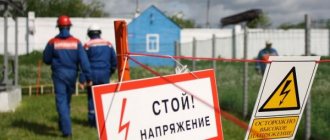Private individuals who do not have individual entrepreneur status or are not in an employment relationship cannot obtain permission to work in electrical installations. A certificate of knowledge testing is not a diploma of qualifications, but proof of compliance with the position/profession held before the next certification for the electrical safety group.
| Group | Who is assigned | Assignment during initial certification | Examples of positions, works | Where to get certified |
| I | Non-electrical personnel. Workers do not service electrical installations, but can be injured by electric current when using office equipment and household electrical appliances in the workplace. | — | Director (without the right to inspect the operating authority), accountant, sales manager, legal adviser. | Assigned at the place of work by a specialist with Group III in ELB after instruction |
| II | Electrotechnical and equivalent electrotechnological. Workers interact with electrical installations without the right to turn off/switch/turn on, or use hand-held power tools, electrical equipment, or electric-driven mechanisms. | Yes | Cleaner of industrial premises, cook, turner, complex maintenance worker for buildings and structures, elevator operator, electric and gas welder. | Commission at the enterprise Rostekhnadzor Commission (RTN) |
| III | Electrotechnical and equivalent electrotechnological. The most common group among blue-collar professions. The employee has the right to disconnect/switch/shut down power equipment, perform work in the order of routine operation, and monitor the safety of other team members. An electrical technician with group III assigns group I to non-electrical personnel. | No | Electrician, car mechanic, electrical engineer, controller of an energy sales organization, electrician, boiler room operator, electric arc furnace operator, SSDTU engineer. | Commission at the enterprise RTN commission: up to 1000 V up to and above 1000 V |
| IV | Electrical technical personnel, including administrative and technical personnel. Qualification allows you to perform work on servicing electrical installations, including those with increased danger; direct the actions of the brigade; issue permits and orders. | No | Responsible for electrical equipment in an organization with power plants up to 1000 V, site foreman, chief engineer of an organization that consumes electricity, chief power engineer. | Commission at the enterprise RTN commission: up to 1000 V up to and above 1000 V |
| IV with the right of inspection | Non-electrical personnel. Officials exercise control and technical supervision at electrical installations. They are not engaged in maintenance and are allowed to enter energy facilities (except for electric power organizations) accompanied by operational personnel. | Yes | Occupational safety specialists, GIT, RTN inspectors. | RTN Commission |
| V | Electrical technical personnel, including administrative and technical personnel. Our specialists are competent in performing work of any complexity on entrusted electrical installations. They can explain safety rules to other employees at targeted briefings, and organize scheduled and emergency work. The functions include control and technical supervision of electrical installations up to and above 1000 V and at electric power enterprises. | No | Chief engineer, other executives, labor protection specialists of electric power industry organizations; RTN and GIT inspectors with the right to inspect electrical installations; those responsible for electrical equipment above 1000 V. | RTN Commission |
Normative base
Order of the Ministry of Labor of Russia dated July 24, 2013 N 328n “On approval of the Rules for labor protection during the operation of electrical installations”
Order of the Ministry of Energy of Russia dated January 13, 2003 N 6 “On approval of the Rules for the technical operation of consumer electrical installations”
Order of the Ministry of Labor of Russia dated July 24, 2013 N 328n “On approval of the Rules for labor protection during the operation of electrical installations”
Categories of workers
The following categories of electrical safety personnel are distinguished:
- electrotechnical;
- electrotechnological;
- non-electrical.
Electrotechnical
It includes:
- Administrative staff. For example, chief engineer, workshop manager, etc. These are workers who are responsible for planning and organizing work related to electrical equipment.
- Operational, repair and operational repair services of the enterprise. These include personnel involved in various transfers, admission of workers to workplaces, and supervision of their activities. If they have special training, they are allowed to participate in eliminating accidents and various malfunctions at the site, and they have the right to provide assistance to employees engaged in repair work in production.
- Subject matter specialists of the departments. This category includes engineers, electricians, welders, electricians, etc. Which electrical safety group a welder should have depends on the danger of the work he performs.
Electrotechnological
An employee is included in this category if:
- in a controlled technological process, the main component is electrical energy (for example, electric welding, electric arc furnaces, electrolysis, etc.);
- use hand-held electric machines, portable power tools and lamps;
- The job description establishes knowledge of PT.
The electrotechnological category includes:
- Administrative and technical employees, that is, managers and specialists whose work is related to operational and technical maintenance, commissioning, repair and installation work in installations.
- Operational employees who carry out routine maintenance and management of installations. They are engaged in inspection, preparation of workplaces, operational switching, admission, supervision of other workers, and performance of tasks within the framework of the ongoing operation of equipment.
- Operational and repair workers. These employees are specially trained to service the installations assigned to them.
- Maintenance workers who are responsible for maintenance, installation, testing, and commissioning of equipment.
Obtaining an electrical safety group for electrical and electrical engineering personnel occurs in accordance with the “List of positions that require assignment of a group...” established at the enterprise.
Non-electrical
This category includes all other employees whose work cannot completely exclude the possibility of electric shock (the specific list of positions is determined by order of the employer): a secretary working at a computer.
Persons included in this category are assigned group 1. That is, they must have the minimum knowledge of electrical engineering and safety regulations that is necessary to perform the work entrusted to them without risk to health and life.
We will describe electrical safety groups and the conditions for their assignment in 2020.
Types of knowledge tests
Testing employee knowledge is divided into areas in accordance with GOSTs and rules:
- primary;
- repeated;
- next;
- extraordinary.
A repeat check is carried out if the employee has not passed the tests under the program. In this case, a month is given for preparation and the commission takes the exam again.
Primary
Before directly performing production duties, persons whose activities are related to electrical equipment must undergo training and then pass exams.
If the duration of the break in work was more than 3 years, then it is necessary to re-train and be certified.
Next
Admission is granted for a year, and after this period the tests are required to be taken again, but for certain categories this period can be reduced. The protocol and certificate indicate the date of the next inspection.
Extraordinary
This type of certification can be carried out when the following circumstances arise:
- If changes or additions to regulations, including local ones, have come into force.
- After repair work or reconstruction of existing technical means and devices.
- If safety requirements are violated, it does not matter whether this situation led to an accident, accident or incident or not.
- At the request of higher authorities, for example, the Ministry of Labor or Rostechnadzor.
- If the break in work lasted more than six months.
Classification
There are several electrical safety groups that are enshrined in law. This classification allows a worker to perform work in electrical installations and determines the level of his training.
Workers are usually divided into five categories.
1st is assigned to non-electrical workers. Their work is not related to working with electrical installations.
What electrical safety groups, which determine the required amount of employee knowledge, are established for electrical personnel is written in the order of the Ministry of Labor of Russia dated July 24, 2013 No. 328n (as amended on February 19, 2016) “On approval of the Rules for labor protection during the operation of electrical installations” ( registered with the Ministry of Justice of Russia on December 12, 2013 No. 30593) and the order of the Ministry of Energy of Russia dated January 13, 2003 No. 6 “On approval of the Rules for the technical operation of consumer electrical installations” (registered with the Ministry of Justice of Russia on January 22, 2003 No. 4145).
Timely training and qualifications
The training center of the Unified Certification Center offers training in electrical safety to personnel of any category and clearance. We have programs for specialists, managers, and labor protection engineers. Duration of training – 72 hours. It is possible to take the course face-to-face or remotely without interrupting work.
An electrical safety certificate is only valid if training courses and exams are held through Rostechnadzor. Our training center is certified by RTN, which guarantees departmental approval of the developed programs and their compliance with all norms and regulations.
Training allows you not only to obtain permits or extend their validity, but also makes knowledge more relevant and skills more professional. All this further affects the safety of working with electrical installations.
First, initial, admission group
This applies only to non-electrical personnel. Before starting work, employees in this category must undergo training.
IMPORTANT!
What electrical safety group is needed for an employee assigned to electrical safety group 1 in organizations with electrical installations over 1000 V? A specialist with a clearance group of at least three is appointed responsible for conducting the briefing: third, fourth or fifth.
After the employee completes the training, a record of this is made in a special journal. The citizen gets acquainted with her under his personal signature. The instructor also signs the log.
| I | |
| Personnel requirements | Conditions of assignment |
|
|
Fines and sanctions
The employer is obliged to monitor compliance with the deadlines for periodic testing of the knowledge of personnel engaged in servicing electrical installations. Delay in deadlines means that the management of the enterprise allowed an employee to perform special work who does not have a confirmed level of necessary qualifications for this purpose. Admission with an expired document risks administrative liability in accordance with Art. 9.11. Code of Administrative Offences.
The nature of liability and the amount of the fine depends on the category of the offender:
- individuals and representatives of line personnel pay a fine of 1-2 thousand rubles for a expired certificate;
- officials responsible for the current situation (director, person responsible for electrical equipment at the enterprise) - a fine of 2-4 thousand rubles;
- individual entrepreneurs operating without forming a legal entity - 2000-4000 rubles or suspension of activities for a period of up to 3 months;
- legal entities – a fine in the amount of 20 to 40 thousand rubles or suspension of proceedings for up to 90 days.
Such sanctions are provided if the performance of official duties with an expired certificate did not have serious consequences. If they lead to an accident, the death of a person, then the provisions of Art. 143 of the Criminal Code of the Russian Federation.
Second admission group
Assigned to workers who are not directly related to electrical installations, but who use electric tools when performing work, where electrical safety is important. Upon receipt of each subsequent category, the conditions for assigning electrical safety groups to personnel change, and new requirements are added.
| II | |
| Personnel requirements | Conditions of assignment |
|
|
Third group of admission
A specialist assigned to group 3 receives permission to work independently or the opportunity to work in a team that works with electrical installations over 1000 Volts. In this case, the corresponding explanation is indicated in his certificate.
| III | |
| Personnel requirements | Conditions of assignment |
|
|
Who should have a certificate
The latest changes in the legislation regulating the admission of consumers to work with electrical installations came into force in 2018. The legislator expanded the list of specialists who must undergo periodic training in electrical safety and confirm their qualifications in an exam with a special commission.
It is mandatory to pass a knowledge test to obtain an electronic security permit:
- Workers in the categories of electrical, electrical technology, non-electrical (second group only) personnel.
- Safety engineers who monitor the operation of electrical installations.
- State inspectors supervising compliance with the rules for the technical operation of electrical equipment.
The next certification can be carried out by a special commission (SDC), created within the enterprise, or in state energy supervision authorities. The second method is mandatory for members of the Labor Code, occupational safety specialists responsible for electrical equipment. The RTN exams are taken by employees of enterprises whose numbers do not allow them to create their own commission.
Fourth admission group
This category of persons is approved for electrical safety as personnel to work on installations with voltages over 1000 V. An employee who has this right has the right to bear responsibility for electrical facilities and train young employees.
| IV | |
| Personnel requirements | Conditions of assignment |
|
|
ELECTRICAL SAFETY Frequently Asked Questions (FAQ)
How many people should be on the enterprise commission for personnel certification?
In order to test the knowledge of the electrical and electrical engineering personnel of the organization, the head of the Consumer must appoint, by order of the organization, a commission consisting of at least five people. The chairman of the commission must have electrical safety group V for Consumers with electrical installations with voltages up to and above 1000 V and group IV for Consumers with electrical installations with voltages only up to 1000 V. The chairman of the commission is usually appointed as the person responsible for the electrical equipment of the Consumer. All members of the commission must have an electrical safety group and pass a knowledge test in the commission of the state energy supervision body.
Who assigns electrical safety group 1 to non-electrical personnel?
Employees from among electrical technical personnel with an electrical safety group of at least III group. up to 1000 V 1 group is assigned to one person who has a group of at least three (without creating a commission and with an entry in the registration log of group 1), cleaners of electrical premises working with power tools, auxiliary workers of non-electrical personnel, etc. No certificate will be issued.
What kind of electrical safety group should managers have who are directly subordinate to electrical personnel?
The group is no lower than that of subordinate personnel, since they provide technical guidance and control over its work.
What is an “electrical safety permit”?
This is sometimes called electrical safety certification. Electrical safety permit - the right to work in electrical installations.
Which electrical safety group should a person allowed to perform work in electrical installations with voltages up to 1,000 V have?
Not lower than IV group.
Who can be appointed responsible for electrical equipment in electrical installations up to 1000 volts?
Responsible for electrical equipment in electrical installations up to 1000 volts can be assigned to a person who, after testing knowledge and instructions, has been assigned group IV, certified as administrative and technical personnel.
Who can carry out maintenance of electrical installations of consumers in the organization?
Operation of Consumers' electrical installations must be carried out by a special service staffed by qualified electrical personnel. It is allowed to operate electrical installations under an agreement with a specialized organization.
What responsibilities for organizing the operation of electrical installations are assigned to the person responsible for electrical facilities?
The responsible person is obliged:
- Organize the development and maintenance of the necessary documentation on the operation of electrical installations;
- Organize training, instruction, testing of knowledge and permission to work independently for electrical technical personnel;
- Organize the safe performance of all types of work in electrical installations, including with the participation of seconded personnel;
- Ensure timely and high-quality performance of technical maintenance, preventative maintenance;
- Organize calculations of consumer needs for electricity and monitor its consumption and rational consumption;
- Participate in the development and implementation of measures for rational energy consumption;
- Monitor the availability, timeliness of inspection and testing of protective equipment in electrical installations, fire extinguishing equipment and tools;
- Ensure the establishment of a procedure for admitting specialists to electrical installations to carry out work on connecting new and reconstructing existing electrical installations;
- Organize prompt maintenance of electrical installations, prevent and eliminate emergency situations;
- Obliged to: a) check the compliance of power supply diagrams with actual operational diagrams and check them at least once every 2 years; b) control the quality of supplied electricity at least once every 2 years; c) improve the qualifications of electrical technical personnel at least once every 5 years;
- Monitor the availability and compliance with the permit requirements of construction, installation and specialized organizations involved in work in existing electrical installations and in the security zone of power lines;
Note: The rights and responsibilities of the person responsible for electrical equipment must be specified in his job description.
In what case is electrical personnel required to undergo an internship (industrial training)?
A) Before being assigned to independent work. B) When moving to another job or position related to the operation of electrical installations. C) If there is a break in work for more than 1 year.
What type of electrical personnel are divided into?
A) Administrative and technical personnel. B) Operations personnel. B) Maintenance personnel. D) Operations and repair personnel.
How is the 1st electrical safety group assigned to non-electrical personnel?
This is done through instruction. Knowledge acquisition is carried out in the form of oral questioning and testing in practice the acquired skills of safe methods of carrying out work and providing first aid to victims.
What type of testing is established for an employee if there is a break in testing knowledge for more than 3 years?
Primary. Only group II.
What type of testing is established for employees who increase their knowledge to a higher group?
Extraordinary inspection.
Where are the results of testing the knowledge of electrical workers documented?
Based on the results of the knowledge test: a protocol is drawn up; a journal entry is made; a certificate is issued.
What is necessary for certification according to PTEEP?
1. Completed electrical safety logbook (“Logbook for testing knowledge of norms and rules of work in electrical installations”, see IPBEE Appendix No. 7). 2. A completed certificate issued by the organization upon hiring or in case of loss of the previous certificate. The certificate must be filled out on the 1st page, certified by the seal of the organization, have the signature of the manager or person responsible for electrical equipment, the Certificate must have a number assigned by the organization. (see IPBEEAppendix No. 2). 3. In case of certification for a group higher than II, it is necessary to provide documents (magazine or certificate) confirming the previous certification.
What group can be assigned to an employee who did not present documents indicating previous certification, but only stated that he: 1. was certified previously or 2. has extensive work experience?
In the absence of documents confirming a previously conducted certification, the employee is certified only for group II.
What is the maximum period allowed between assessments?
If there is a break in testing knowledge for more than 3 years, only the primary knowledge test for group II up to 1000 V is carried out (see PTEEP clause 1.4.19).
Can the group be promoted during an extraordinary certification due to a change in position or a change of place of work?
When changing a position or place of work, the previous (extraordinary knowledge test, see PTEEP clause 1.4.23) group is first confirmed, and then, if necessary, an extraordinary certification is carried out to increase the group.
Minimum time between certifications, if it is necessary to increase the group?
- During the initial certification for group II, certification for group III is carried out no earlier than two months later.
- After certification for group III for the first time, certification for group IV is carried out no earlier than three months later.
- If the employee being certified from among managers and specialists has a higher electrical engineering education, the intervals between certifications are reduced by 1 month each (a copy of the diploma must be attached to the documents listed above)
What must be reported about an employee in an application for electrical safety certification?
- Fully indicate the full name and position of the employee as it is recorded in personnel documents,
- length of service in this position at this enterprise,
- date of the last electrical safety certification and
- group that was previously assigned. (The same information should be recorded in the journal).
- In the column about the upcoming certification, you must write which group should be assigned to the employee and as which personnel.
Who has the right to service batteries and chargers?
Specially trained personnel with electrical safety group III
Who in the organization monitors the operation of measuring and accounting instruments for electrical energy, including recording devices and devices with automatic acceleration of recording in emergency modes?
Operational or maintenance personnel
Who does the Labor Safety Rules apply to when operating electrical installations?
For employees from among electrical, electrical and non-electrical personnel, and for employers, regardless of ownership and organizational and legal forms), engaged in maintenance of electrical installations, carrying out operational switching in them, organizing and performing construction, installation, adjustment, repair work, testing and measurements
Who is covered by the Rules for the Technical Operation of Consumer Electrical Installations?
For organizations, regardless of ownership and legal forms, individual entrepreneurs operating existing electrical installations with voltages up to 220 kV inclusive, and citizens who own electrical installations with voltages above 1000 V
In which electrical installations is a person responsible for electrical equipment appointed?
In all electrical installations, except those where the owners of electrical installations above 1000 V are citizens or the electrical equipment includes only ASU, lighting installations and electrical equipment with a voltage not exceeding 380 V
Who approves the List of positions and professions of electrical personnel who need to have an appropriate electrical safety group?
Head of the organization
Where is the electrical safety knowledge of those responsible for electrical facilities and their deputies tested?
In the territorial commission of Rostechnadzor
Which electric current is more dangerous for humans: direct or alternating?
Up to 380 V, alternating current is more dangerous, and above 500 V, direct current is more dangerous than alternating current.
Fifth admission group
As a rule, it is owned by engineering and technical personnel. This is the highest category, the presence of which gives permission to manage and manage tasks on equipment under any voltage and perform the duties of a manager of electrical facilities.
| V | |
| Personnel requirements | Conditions of assignment |
|
|
The approved procedure for assigning electrical safety tolerance groups must be observed. Receiving the next group is allowed only if the assignment conditions are met.
Basic information about electrical safety approval
An electrical safety permit is a document that allows a specialist to carry out various work on electrical installations and confirms the appropriate level of his skills and knowledge, as well as experience. Workers who have received level 2-5 clearance have the necessary qualifications. After additional preparation and registration of this type of permit, the risk of emergencies and incidents at your facility will be significantly reduced.
Before obtaining admission, you must undergo specialized training at the organization’s training center or a third-party educational institution and pass exams. Based on their results, the specialist will be assigned a group corresponding to his position, work responsibilities, as well as experience and knowledge. With such a document, he will be able to carry out work with installations of a certain capacity and purpose.
| Stage | Peculiarities |
| Primary training | Necessary for employees who have just been hired, do not have confirmed status, and specialists with less than three years of experience. |
| Repeated planned training | Required for all specialists on a regular basis. The main employees of enterprises must attend lectures once a year, managers, foremen, foremen of various levels - once every three years. |
| Unscheduled training | It is necessary for specialists who want to move to another position, gain access to more powerful installations or complex activities, but do not have sufficient knowledge and skills for this. |
| Certification | Carried out after each training cycle. Allows you to get a new group. |
Note! The employer must organize training and certification of specialists. He is obliged to pay for educational services, all kinds of fees and commissions, as well as cover additional expenses, if any.
The level (group) of admission depends on education, job responsibilities, category of the employee, as well as the maximum installation voltage allowed at the facility.
The following organizations can issue permits:
- Certification Commission of Rostechnadzor (territorial body).
- Specialized training centers that have accreditation (the issuing commission must be headed by a Rostechnadzor inspector).
- Internal commission of the company for which employees are trained. Such a commission must include at least five specialists, three of whom are required to obtain accreditation in advance from an educational organization (training center).
The choice in favor of one option or another depends on the size of the enterprise, the number of specialists, and location. Most often, it is convenient for companies to contact training centers.
Where do they rent for groups?
The exam for admission groups 2-5 takes place in the Rostechnadzor division that conducts training and certification of employees.
Training is carried out in the direction of the enterprise, in which it is necessary to indicate:
- employee position;
- his length of service in this position;
- required level of clearance.
Some organizations have their own permanent commission. She accepts exams and submits a draft order for the assignment (or upgrade) of qualifications to management for consideration. The commission must include:
- Chairman with electrical safety approval 5 (at voltages above (up to) 1000 V) and 4 (at voltages less than 1000 V). This is the person responsible for the electrical part;
- vice-chairman;
- secretary;
- at least 3 commission members.
After completing the training program and successfully passing the exam, employees are assigned categories of electrical engineering personnel (from 2 to 5). The corresponding mark is made in the certificate, the form of which is presented in Appendix No. 3 to the rules on labor protection during the operation of electrical installations, approved by Order of the Ministry of Labor of the Russian Federation dated July 24, 2013 No. 328n. The certificate is valid until the position changes.
Procedure for obtaining a certificate
The most important innovation in the field of electrical safety regulation is the ban on training centers issuing certificates. If a company offers to quickly issue all permits without the participation of Rostechnadzor, you will receive an illegal and invalid document. Therefore, it is worth choosing proven training centers accredited by RTN, which are responsible for the quality of training and accompany the entire process of preparation and passing the exam in accordance with all norms and rules.
There are 3 ways to pass a regular or unscheduled knowledge test:
- Beginners must complete a full training course lasting up to 1 month. Those who receive permits in this way increase their chances of employment or transfer to a more responsible position.
- Courses at the training center without interruption of work with further certification in Rostechnadzor. The duration of the programs is 72 hours.
- Creating your own commission within an enterprise is a suitable option for organizations with a staff of 50 or more people.
The last option is the least expensive for the enterprise, but requires qualified personnel. The chairman of the commission can only be a holder of level 4 or 5, members of the commission (3-5 people) - at least 3 groups.
Duration and price of education
Applications for training are accepted by licensed training centers. We will show in the table the groups of electrical safety clearance for electrical installations up to and above 1000 V, the time it will take for training, and the estimated cost.
After training, students know everything that, according to the standards, is required for the corresponding category of admission.
Certain types of work permitted for the third group
Grounding. An electrician with the third electrical safety group can independently apply grounding in electrical installations up to a thousand volts. It is possible to remove grounding connections and disconnect grounding blades with group 3 in electrical installations of any category.
Checking for no voltage. In electrical installations up to 1000 V, one person with electrical safety group III or higher can check the absence of voltage with a two-pole indicator.
Measuring insulation resistance with a megohmmeter. Measuring insulation resistance with portable megohm meters can be performed by persons with electrical safety group III.
As can be seen from all of the above, an electrician with electrical safety group III from among the repair or operational personnel has all the necessary rights to perform work in electrical installations up to 1000 V










